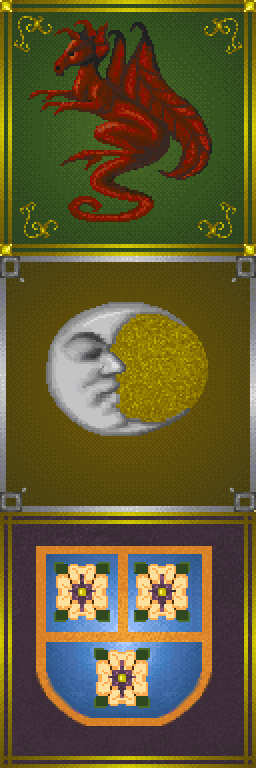Lore:War of Betony
| War of Betony | |||
|---|---|---|---|
 Fighting During the War of Betony Fighting During the War of Betony |
|||
| Date | 3E 402 – 3E 403 | ||
| Location | Iliac Bay, High Rock | ||
| Result | Daggerfall victory
|
||
| Participants | |||
| Kingdom of Daggerfall | Kingdom of Sentinel | ||
| Commanders and Leaders | |||
The War of Betony (sometimes the Siege of Betony[1]) was a military conflict between the Kingdoms of Daggerfall and Sentinel, spurred on from the wars embroiling Tamriel during the Imperial Simulacrum period,[2][UOL 1] in this case, the Wars of the Iliac Bays.[3] The war was sparked when Lord Mogref of Betony, an island strategically located in the entrance to the Iliac Bay, asked King Lysandus of Daggerfall for protection against pirates and other brigands. King Camaron of Sentinel and his advisors, citing an old contract that suggested Betony was a holding of their kingdom, declared war. Hostilities ended after Lysandus' son, Gothryd, who became king after his father was killed in battle at Cryngaine Field, won the battle. Camaron would also die before the conclusion of the battle. Sentinel surrendered and Betony passed under the control of Daggerfall. As part of the peace settlement, King Gothryd married the daughter of the late King Camaron, Princess Aubk-i.
The most primary documentation of the conflict comes from two books, both called The War of Betony. Vulper Newgate's version contains the official history, as written by the victors; Fav'te's book, however, tells the story from the viewpoint of a citizen of Sentinel. The Daggerfall Chronicles authored by the Scenarist Guild also provides full coverage of the events.[4]
Contents
Background[edit]
The Iliac Bay was a fractious and conflict-ridden region primarily divided between the powers of Daggerfall, Sentinel, and Wayrest. Daggerfall and Sentinel would often find themselves in conflict for dominance as the premier military power of the region, and Daggerfall and Wayrest would similarly compete for control of trade.[5] A fourth power would spend most of the history of the Bay being suppressed and attacked by the other powers, Orsinium.[6][7]
Daggerfall's monarch during this period was King Lysandus. Unusual for a ruler at the time, Lysandus was noted to hold sympathies for the Orc population, likely inspired by watching a campaign of extermination against them in his youth.[8] Prominent figures of his court included his mother Nulfaga, his wife Queen Mynisera, and his court sorceress and lover Medora Direnni. All three were noted for their magical prowess. His issue consisted of Prince Gothryd, the sole child he would have with his wife.[4][9][10]
The Court of Sentinel was ruled by King Camaron. His wife was Queen Akorithi, a union that would prove more productive and result in the children Arthago, Aubk-i, Greklith, and Lhotun. Out of disgust for the scholarly nature of his eldest son Arthago and to secure the succession for his preferred son Greklith, Camaron would have his son abducted and left to die in 3E 400.[4]
Wayrest, similar to the role it would play in this conflict, featured the most complicated court. The elderly King Eadwyre had outlived his wife Queen Carolyna, who was also survived by their daughter Princess Elysana. In a move that would prove to be tumultuous, Eadwyre remarried. Queen Barenziah brought with her own children from her previous marriage to General Symmachus, Prince Helseth and Princess Morgiah. Helseth and Elysana would immediately begin competing, plotting, and scheming to become the true heir to Wayrest. Elysana was betrothed to a rising noble known as Lord Woodborne, who was secretly plotting with Prince Gothryd to usurp the throne of Wayrest for himself. Although he had reached out to King Lysandus with the same plot, the King of Daggerfall proved to be unwilling to engage in that form of skullduggery.[11][4]
Orsinium, while lacking the critical formal recognition needed to protect its population, was working to achieve that status. The King of Orsinium was Gortwog gro-Nagorm, who won the land through enforcing a claim via a duel against a Wayrest noble.[12] As previously noted, their cause had found an unlikely ally in King Lysandus.
Ruling over all of the temporal powers was the Septim Empire, which would wax and wane in influence over the centuries of the Third Era. By the opening years of the fifth century of the Third Era, the Empire was in a period of waning influence. Unbeknownst to most of the people of Tamriel, Emperor Uriel Septim VII was secretly replaced by the Imperial Battlemage Jagar Tharn. Although the usurper took Uriel's place, he refused to continue his policies to further solidify Imperial power, and seemingly adopted policies that would solely bring ruin and conflict to Tamriel. By the end of his ten year reign, the Empire was greatly weakened. Despite Uriel VII's efforts to correct the situation, he would prove incapable of correcting the situation to put a stop to this infighting in his empire.[13][14][15][15][16]
Prelude to War[edit]
As its name suggests, the coming conflict centered around the island of Betony. Although closer to High Rock's Glenumbra peninsula, prior to the coming conflict the island shared closer ties with the Hammerfell kingdom Sentinel according to Fav'te's account. Newgate instead described the island as being independent, and Sentinel's claim as a potentially illegal 200 year old contract declaring Betony to be a "traditional holding" of the Kingdom of Sentinel. The sparsely populated[17][4] fishing island's true value lay with its strategic position, which would prove to be a major asset to whichever power that controlled the island.[1][18]
Circa 3E 402, Betony, little more than a village, was being constantly plagued by attacks from pirates. Fav'te claimed that these pirates raids were in fact being sponsored by King Lysandus, who desired to conquer the island and was waging a silent war to gain it. Lord Mogref of Betony saw his continued de facto independence as untenable. He formally requested for vassalization to the Kingdom of Daggerfall, in return for the protection of the crown[18] and a monetary reward for himself.[4] Sentinel's preferred account instead claimed that Lysandus illegally invaded and occupied the island.[1]
Sentinel diplomatically protested this, citing a 200 year old treaty.[4][18] These objections would fail to move Daggerfall. As both kingdoms prepared for war, conflict began within their courts. Fav'te would claim that almost all of Lysandus's advisors would try to convince him to end the conflict, including his court sorceress Medora and his mother Nulfaga. Instead of heeding their counsel, all opposing voices would be expelled from his court.[1] This would prove to be untrue for Medora and Nulfaga, who would truly leave his court later on and for different reasons.[4] Newgate instead claims that most of Sentinel's court was for the war, with the notable opposition from Camaron's chief advisor The Oracle, who reportedly could see the future. The Oracle claimed to see only death and defeat in the war, earning her banishment.[18]
With neither side willing to cede Betony without a fight, war became inevitable. During the year 3E 402 King Camaron the White Moon of Sentinel declared war on King Lysandus the Dragon of Daggerfall.
The War of Betony[edit]
The course of the military conflict known as the War of Betony shows one side as having a clear advantage, Daggerfall. Every single major battle of the war would be won by Daggerfall.[18] Fav'te attributes the Breton edge to magic and espionage, which Camaron and his fellow Redguard refused to use over more conventional and "honest" tactics. Still, this would not prove to be enough to bring an end to the war, and the minor powers of the Iliac Bay began to be drawn into the conflict.[1]
The first major battle of the war would also be the first battle altogether. The Battle of the Bluffs, a naval battle, would take place off the coast of Daggerfall shortly after the war began. Daggerfall's forces were put under the command of Lord Bridwell, the leader of the Knights of the Dragon.Both sides first sent main infantry squares to attack each other in traditional combat, followed by night raid with Nightblade force on each other's flanks and rear. As general,[Note 1] Bridwell proved to very capable, and secured victory thanks to his "bravery and leadership".[4][18]
Sentinel's navy lie defeated, but not utterly destroyed. They would go on to threaten the Isle of Craghold and put the garrison under siege for several days. Lord Bridwell would once again prove victorious when he went to relieve the defenders.[18][19]
Although a few minor engagements would see Sentinel succeed, their loss records saw their next major entry at the Battle of Glenpoint Hills. During this battle the leader of the Order of the Candle, Lord K'avar would suffer a disfiguring injury by a fireball thrown by a Dark Elf mercenary.[4]
The poor performance of the Kingdom of Sentinel for such a martially-inclined culture left a notable impression on the memories of the war. Numerous jokes were created about Sentinel's forces after the conclusion of the war.[19]
A Court in Crisis[edit]
Although Lysandus, Gothryd, and Bridwell were winning the war for Daggerfall, the court did not fare well in their absence. While away, Queen Mynisera uncovered evidence of her husband's affair with Medora, and promptly banished her. She would also place a curse on the court sorceress, trapping her in Direnni Tower.[20] Medora would leave, still desperately hoping her lover Lysandus would end the war before his death. Nulfaga would also repeatedly beg her son to end the conflict, as her magical abilities foresaw he would die if the war continued. Nulfaga, dejected and surrounded by opposing voices, ultimately decided to leave Daggerfall for her castle Shedungent rather than watch her son die, leaving behind her dragon familiar Skakmat to observe the court in her place.
His mother's leaving and the banishment of his lover proved to be what it took to convince Lysandus to begin peace negotiations.
The Treaty of Gradkeep[edit]
Reich Gradkeep (now known as Anticlere) was chosen as the site to negotiate a peace between Daggerfall and Sentinel. The neutral High Rock fiefdom would see King Lysandus, King Camaron, Lord Bridwell, a Daggerfall Priest of Kynareth named Vanech, and soldiers from both sides arrive for the negotiations, with Lord Graddock, Lady Graddock, and their heir Mara Graddock acting as hosts.
By all accounts, the negotiations started off very well. All parties acted amicably, and it seems genuine compromise and terms were achieved. The ensuing breakdown in negotiations is similarly universally attributed to the written treaty not being reflective of the previous agreements. A summary of what these terms were, and what caused the breakdown according to each major account follows:
Fav'te's Version
- Lord Graddock had appealed to both parties and was responsible for beginning the peace negotiations.
- King Camaron was "excessively generous" and offered to give up some of his rights to Betony.
- The written treaty was purposely miswritten by a Daggerfall scribe, which was immediately noticed by King Camaron.
- The room erupted into conflict shortly thereafter, with no mention of who started the fighting. Reich Gradkeep would be massacred, and Daggerfall and Sentinel would encamp at Ravennian Forest and Yeorth Burrowland respectively.
Newgate's Version
- Lysandus began peace negotiations by reaching out to Lord Graddock to facilitate them.
- King Camaron, at a disadvantage in the war, was initially courteous.
- King Camaron flew into a rage after realizing the treaty would include a formal agreement to share Betony.
- King Camaron ordered his troops to begin rioting, slaughtering the neutral occupants of Gradkeep's palace and city, with Daggerfall's forces bringing order to the chaos and routing Sentinel's army. Sentinel fled to Yeorth Burrowland, and Daggerfall chased until Ravennian Forest where they made camp.
Scenarist Guild's Version
- Lysandus decided to seek peace, with Reich Gradkeep chosen as a meeting place for him and Camaron.
- The meeting was conducted civilly by both parties.
- The Priest Vanech deliberately sabotaged the meeting, seeing Betony as a holy land of Kynareth. He produced a fake treaty that was designed to offend Lysandus, although how is not specified.
- "According to legend" Lord Bridwell started the riot by shattering the negotiating table with a battleaxe. Camaron realized what Vanech had done and personally killed him. Meanwhile the Graddock's tried to restore peace, but would fail. Soldiers and civilians from Daggerfall, Sentinel, and Reich Gradkeep began fighting, leaving the palace "soaked in blood".
The Battle of Cryngaine Field[edit]
The conclusion of the War of Betony would take place in Cryngaine Field during the year 3E 403. Over the course of the week that followed the breakdown in negotiations, the Daggerfall and Sentinel camps received reinforcements to prepare for their final engagement. And it was during this week that King Lysandus plotted to fake his death.[4]
Like all of the other major battles of the War of Betony, Daggerfall once again proved victorious at Cryngaine Field. The armies broke camp and clashed in the field, only for a strange mist to descend, causing chaos for both sides. During the chaos, King Lysandus was struck with an arrow from a Sentinel archer, either in his heart[4] or his throat, killing him.[18][1]
Gothryd was crowned mid-battle, not far from the battle lines.[18] Inspired by their new king in full regalia urging them on, the battle turned decisively in the favor of Daggerfall's forces. King Camaron met his demise shortly after Lysandus, although all three primary accounts are in dispute as to how. Fav'te claims that Gothryd challenged Camaron, who was exhausted from fighting the battle for the full length of the engagement, to a duel. Unable to even defeat the physically spent king honorably, used "dirty trick and black magic" to backstab him before their duel even began.[1] Newgate instead claims that Sentinel's forces began to rout as Daggerfall's was inspired to push on by their new king, and Gothryd engaged and slew Camaron mid-battle.[18] The Daggerfall Chronicles is similar to Newgate's account, except it attributes the death of Camaron to Lord Bridwell instead of King Gothryd.[4]
The Truth of the Battle[edit]
However, not everything was exactly as it seemed to be. Lysandus, heartbroken over his lover being banished for his court, and generally uninterested in ruling, approached his son Gothryd to form a plan for him to secretly leave his crown while still living. The plan that they formulated consisted of Lysandus being replaced by a lookalike to be supplied by Lord Woodborne. During the battle the fake Lysandus would feign death, all the while the real Lysandus would be escaping his life, with the help of Lord Woodborne to live with Medora. Gothryd, "who wanted his father to be happy", agreed to this scheme.[4][8]
Meanwhile, Lysandus's mother Nulfaga, still very worried about his fate, ordered the dragon Skakmat to intervene in the battle by creating a cloud of fog to blind the fighters. It was during this time that Gothryd shot his father's impersonator. Although the plan was for him to just feign death, the arrow proved to be lethal and the impostor king was buried in Lysandus's place.
The Daggerfall Chronicles then claims that Lysandus was betrayed mid-journey by Lord Woodborne. Fearing that the king would prove to still have influence over his son after his "death", Woodborne ordered the Minat Orc Tribe led by Gortwog to kill him just before he was to set sail to join Medora. Lord Woodborne then kept the desecrated corpse of Lysandus as a potential blackmail tool if King Gothryd proved troublesome.[4] Although it points to the right culprit, Woodborne, Lysandus truly died before the Battle of Cryngaine Field. Lord Woodborne assassinated King Lysandus during a meeting between Lysandus and a Wayrest peace envoy.[22][23][24][11]
The potential duplicity of Wayrest against King Lysandus is not entirely clear. Lysandus was a noted sympathizer of the cause to form a province for the Orcish people, earning the natural enmity of Wayrest, who stood to lose land if Gortwog was successful in his efforts.[12] He was also a supporter of the Empire, a position that was not shared by his Sentinel and Wayrest counterparts.[22][4] Although the exact level of involvement the Crown of Wayrest had in Lysandus's death cannot be said, it is clear they were directly aware of the truth of it.[23]
King Gortwog, wishing to prevent the death of one of the rare royal sympathizers to his cause, sent forces to ambush to Wayrest envoy, but they failed to kill the assassin among their ranks. He also attempted to alert Medora Direnni to this plot, but the letter failed to reach her.[22][25]
It is unclear if Gothryd betrayed his father, or if he was even aware his father was truly killed.[Note 2]
Aftermath[edit]
With King Camaron dead and their forces routing, Lord Oresme of Sentinel formally surrendered. Sentinel formally ceded all claims to Betony, and at the same time informally ceded their dispute against Daggerfall as the primary military power of the Iliac Bay. Lord Oresme committed suicide while traveling back to Sentinel, with Newgate claiming it was while aboard a ship and the Scenarist Guild instead stating it was while still on the march.[18][4] The peace terms included a marriage between the newly crowned King Gothryd and Princess Princess Aubk-i.[18] Although this term was intended to help maintain peace between the kingdoms, it was a popular view in Sentinel that the princess was essentially a hostage.[1][4] Queen Akorithi would act as Queen Regent until her youngest son, Lhotun, could ultimately take the throne.[10]
King Gothryd enjoyed a very brief period of popularity as the victor of the War of Betony. However, rumors quickly began to circulate that he was involved in the death of his father after his shade began haunting Daggerfall.[4][26] Still, with a technical alliance with his former adversaries in Sentinel and his secret alliance with Lord Woodborne, as well as his possession of a major artifact, there was no serious direct challenge to his position after the war. The death of Lysandus and marriage of Gothryd caused there to be a change in the identity of the Queen of Daggerfall. The chaos of the war and this change among royalty would lead to some very critical confusion to a courier with a letter from the Emperor.[27]
Wayrest was not threatened by Daggerfall's control of Betony as far as trade goes, thanks to their monopoly over the Bjoulsae River. With Lysandus dead and their armies completely spared from any fighting, Wayrest remained prepared to continue to challenge the Orcish attempts to seize control of the northern region of their kingdom. Unfortunately their temporary stalling of this threat came at the cost of creating one they did not even realize; Woodborne, who was only one heartbeat away from seizing control of the kingdom for himself, and potentially much more.[11]
Nulfaga, having failed to save her son, fell into madness with her grief, isolation, and experiments.[28] Mynisera became the Dowager Queen of Daggerfall, and isolated herself from the rest of the court. Seemingly still loyal to her late husband, she began destroying documents that would shine a poor light on his reputation, particularly his love letters to Medora.[8] Medora, trapped by Dowager Queen Mynisera in her ancestral home, tried to repeatedly summon her lost lover, but repeatedly failed.[25][4]
The pirates who acted as a catalyst for the conflict with their attacks on Betony were forced to disperse, but not by the army of Daggerfall or Sentinel. The buccaneers based their operations out of the isle of Balfiera, which was now haunted by the undead thanks to Medora Direnni. In her failed efforts to summon Lysandus's spirit, she managed to raise undead all over the island, making it too dangerous to continue operating from.[4]
Notes[edit]
References[edit]
- ^ a b c d e f g h The War of Betony — Fav'te
- ^ Daggerfall Introduction
- ^ Assassination!
- ^ a b c d e f g h i j k l m n o p q r s t u The Daggerfall Chronicles — Ronald Wartow
- ^ A History of Daggerfall — Odiva Gallwood
- ^ Wayrest, Jewel of the Bay — Sathyr Longleat
- ^ From The Memory Stone of Makela Leki — Makela Leki
- ^ a b c Events of Mynisera's Letters
- ^ Events of The Missing Prince
- ^ a b Night Falls on Sentinel — Boali
- ^ a b c Events of Lysandus' Revenge
- ^ a b How Orsinium Passed to the Orcs — Menyna Gsost
- ^ Opening narration of Daggerfall
- ^ Pocket Guide to the Empire, 3rd Edition: All the Eras of Man, A Comprehensive History of our History — Imperial Geographical Society, 3E 432
- ^ a b The Real Barenziah, v 5 — Anonymous
- ^ Brief History of the Empire v 4 — Stronach k'Thojj III
- ^ Betony in Daggerfall
- ^ a b c d e f g h i j k l The War of Betony — Vulper Newgate, 3E 404
- ^ a b Jokes — Butha Sunhous
- ^ Events of Medora's Freedom
- ^ Daggerfall CES Cinematic
- ^ a b c Events of Blackmail
- ^ a b Events of Painting the Truth
- ^ Events of Lysandus' Revelation
- ^ a b Events of Dust of Restful Death
- ^ The initial state of the city of Daggerfall in Daggerfall
- ^ Events of The Emperor's Courier
- ^ Events of Concern for Nulfaga
Note: The following references are considered to be unofficial sources. They are included to round off this article and may not be authoritative or conclusive.
|
|||||||||||||||||||||||||





